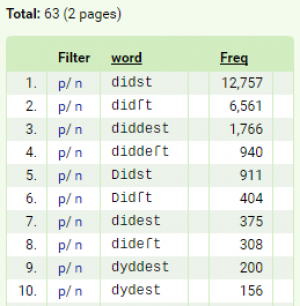This is an old revision of the document!
Table of Contents
Lesson 7: Morphology II
In this lesson we will continue to deal with morphological variantions in Early Modern English. Specifically, we will be looking at the verbal inflections which just like pronouns show a great deal of variation (see Lesson Six).
Verbal endings
The verbal endings for the past tense has not always been as uniform as they are nowadays. In present day English the regular past tense does not take any additional suffixes besides -ed (although some verbs such as did are conjugated irregularly). The form stays the same for all of the persons, e.g. He walked and You walked. However, this has not always been the case. The form of the second-person singular used to be formed by the addition of suffix -(e)st which followed the past tense suffix -ed. We will have a look at one of the most frequent verbs in the English language, an auxilliary verb to do. Specifically, we will be looking at the 2nd person singular allomorphs in the past tense such as did and didst.
While the endings for the third person singular endings -th and -s were only applied to the present tense (see Lesson Three), -(e)st was added to the verbs both in the present and past tense, e.g. The auxilliary verbs were also marked for person, e.g. didst or hadst. During the Early Middle English times, the speaker had an option between two forms: either adding-edst suffix behind the verb or just -ed. Eventually -ed took over in all of the contexts and -edst became an archaic form.
Some of the verbs such as have or do took the incoming ending later than the others. This is an example of lexical diffusion which can be defined as a process during which a linguistics change gradually spreads to all of the relevant verbs but takes longer to get adopted in other contexts (usually words with high frequency such as have).
Searching the corpus
As the spelling was still relatively variable during the period that the EEBO corpus covers, we have to make sure we include all of the spelling variants when searching for the past tense of the second person singular of the verb do. By using the CQL, we can include all of the possible spelling variants (see Lesson Two). Based on the entry in OED which lists all of the variants, our query would be:
[word=“[dD][iy][d](d)?(e)?(i)?(y)?(s)?(ſ)?t(e)?”]
When we click on the frequency button and select node forms in the dropdown menu, we will be able to see which of 63 spelling variants was the most frequently used at that time.
For the purpose of this lesson, we will use the most frequent one, that is didst. Now we can compare frequencies of these two forms: didst and did which eventually substituted the former one in the second person singular.
If we wish to search for both forms in the corpus at the same time we will insert a vertical bar for alternatives as was explained in the previous lesson. This way the concordance list will contain both did and didst in the results. The query is expressed as follows:
[word=“thou”][word=“didst”]|[word=“thou”][word=“did”]
The reason why we need to include the pronoun thou in our query is that did was also used in the first and third person. By including the pronoun, we will be able to eliminate those cases from the concordance list. Didst does not require this restriction as it was only used in the second person sg. but in order to ensure comparability we also have to add the pronoun before did.
Now we click on the Frequency button in the main menu, select Node forms in the dropdown menu and a frequency list will appear as can be seen in the following picture. The results reveal that during the period that is covered by the EEBO corpus, didst was used approximately ten times more frequently than did.
| do | frequency | 1420-1500 (i.p.m.) | 1500-1570 (i.p.m.) | 1570-1640 (i.p.m.) | 1640-1710 (i.p.m.) |
|---|---|---|---|---|---|
| didst | 6,061 | 0 | 2.41 | 9.19 | 6.28 |
| did | 620 | 0.14 | 0.41 | 0.76 | 0.72 |
Variation in derivational suffixes
So far we have been using the EEBO corpus to observe variation in the verbal endings. Now we move on to the derivational suffixes which are used to form new words by addition of the suffix or prefix to the stem, e.g. kind and kindness. English has a lot of derivational suffixes, some of which are no longer productive, i.e. they are no longer used to form new words.
Derivational suffixes -ity and -ness are both used to form abstract nouns out of adjectives, e.g. pure and purity. While -ness is of Germanic origin and has been productive since Old English times, -ity is an etymologically foreign suffix which English borrowed from Latin thorugh French. Its foreign provenance is one of the reasons of its restricted productivity as foreign sufixes usually do not attach to native stems.
To find all of the abstract nouns that could be formed by addition of -ness and -ity we use the following query:
[word=“.*ness”]
We form similiar query for -ity suffix:
[word=“.*ity”]
The full stop wild card subsitutes for any character preceding -ness and asterisk repeats any preceding wildcard. Therefore, any number of characters can precede the suffix.
If we click on the Frequency button and select Node forms in the dropdown menu, we will find out what kind of nouns were formed using the respective suffixes :
| -ness | -ity |
|---|---|
| business | authority |
| righteousness | necessity |
| holiness | quantity |
| goodness | charity |
| witness | quality |
| happiness | opportunity |
| darkness | divinity |
| holiness | nobility |
Although the word City was first in the list of node forms, -ity is part of the stem of the word, not a suffix. There are also some examples of numerals such as thyrity or fity included in the list. When we compare two lists it is obvious that -ness is added to domestic stems which form the core lexis, while -ity words represents the vocabulary of higher register.
Number of node forms
- -ity: 8889
- -ness:9038
The numbers of node forms for each of the suffixes are surprisingly similar, therefore therefore it seems that productivity of -ness is not that much higher as the one of -ity. However, this is not the whole story. Using, the EEBO corpus, we can also observe how did the productivity of these two suffixes alter over the time period that EEBO covers. We just need to Specify query according to the meta-information in the main form and select the period within which we wish to search for node forms.
| period | 1420-1500 | 1500-1570 | 1570-1640 | 1640-1710 |
|---|---|---|---|---|
| -ness | 7 | 101 | 710 | 8796 |
| -ity | 5 | 413 | 3345 | 7543 |
In both cases, the number of node forms is steadily increasing with the lowest number in 15th century and the highest in the 17th century.
Task
Have a look at the suffix -ism or prefix anti-. Find out what kind of words were formed using these two affixes.









